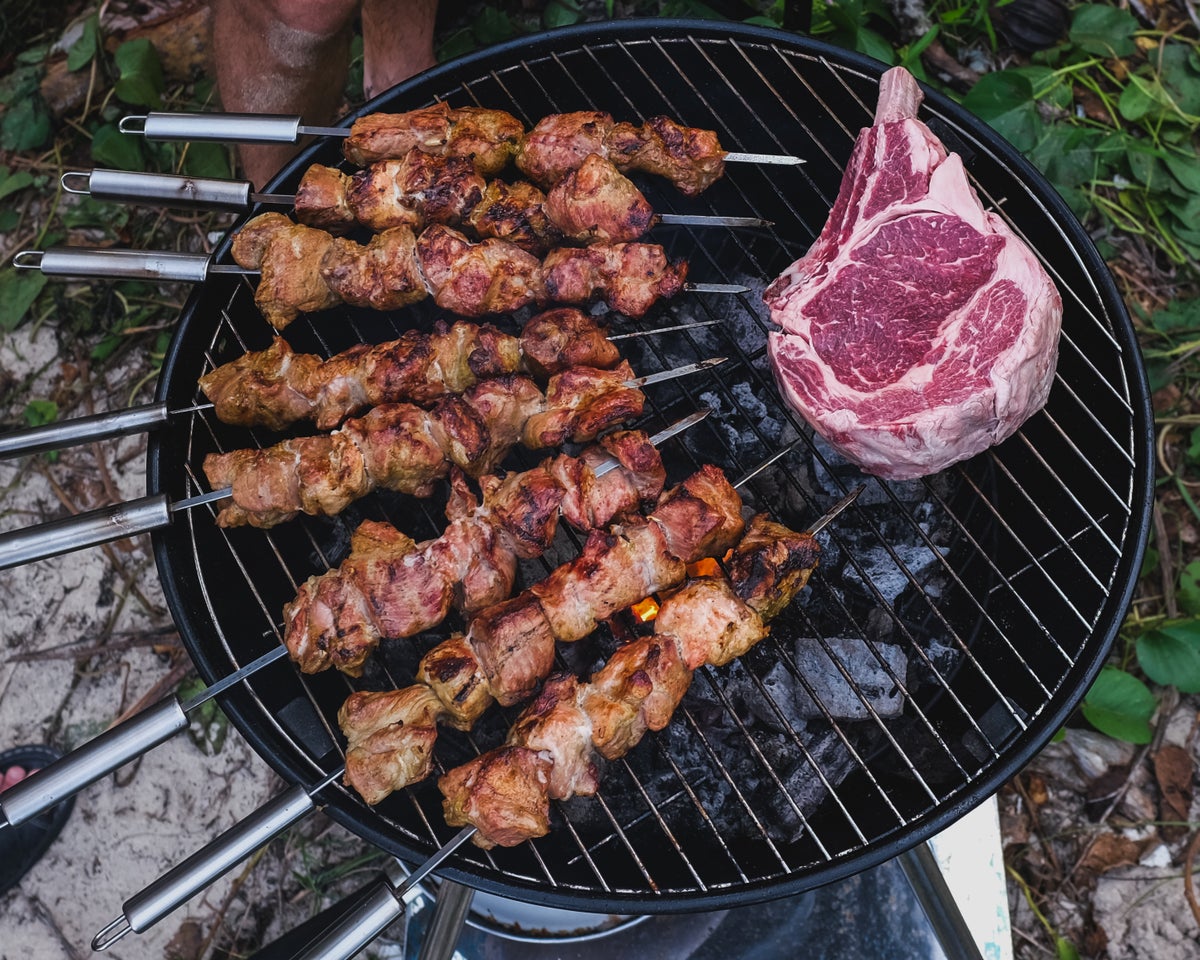How to Grill Meat Safely—According to Science
Juicy skewers of marinated meat are grilling alongside a large, raw ribeye steak on a charcoal barbecue. Every type of meat has its own required cooking temperature.
As the days heat up in the Northern Hemisphere, so do meats at summer barbecues. But the amount of heat you use to cook different meats matters—not only for taste but for health.
Each type of protein—beef, pork, poultry and others—has to reach a recommended minimum temperature to be considered safe to eat. A chicken breast, for example, needs to be heated to at least 73.9 degrees Celsius (165 degrees Fahrenheit) throughout, while a steak or pork chop should reach 62.8 degrees C (145 degrees F). Where do these recommendations come from? And why must some meats be cooked to a higher temperature than others?
If you’re enjoying this article, consider supporting our award-winning journalism by subscribing. By purchasing a subscription you are helping to ensure the future of impactful stories about the discoveries and ideas shaping our world today.
Food poisoning can be caused by viruses or parasites, but the most common culprits are bacteria such as Salmonella, Escherichia coli, Campylobacter, Listeria and Clostridium—often found on or inside animals. These microbes flourish at temperatures between 4.4 and 60 degrees C (40 to 140 degrees F), often doubling in number in as little as 20 minutes. People who eat foods contaminated with these bacteria often experience nausea, vomiting, diarrhea, stomach cramps and fever. Most people recover within a few days, but in rare cases, food poisoning can be fatal.
Cooking meat is one way to kill those harmful microbes. Throughout the 1970s and 1980s, scientists across multiple U.S. agencies, including the Food and Drug Administration, the Department of Agriculture and the Centers for Disease Control and Prevention, turned laboratories into test kitchens to figure out the meat temperature guidelines we use today, says Donald Schaffner, a food microbiologist at Rutgers University. Researchers inoculated various foods, from roast beef and chicken thighs to eggs and leftover casseroles, with bacteria and then prepared the dishes with different culinary methods—say, grilling versus microwaving or roasting. The final guidelines were based on the time it took for a specific temperature to reduce the bacteria by 90 percent.*
Recommendations differ based on factors such as the cut of a given type of meat. Steak or pork, for instance, have dense muscle fibers that are relatively difficult for bacteria to penetrate—and searing the meat kills most microbes lingering on the surface. Ground meat, by contrast, is typically made up of lower-quality cuts from multiple animals, and grinding the meat into bits disperses those surface-dwelling bacteria throughout products such as a burger patty or sausage link. This requires an internal temperature that’s a few degrees higher: 71.1 degrees C (160 degrees F). Poultry also needs to be cooked to a higher temperature (165 degrees F) because it is more likely to be contaminated internally, particularly with illness-causing Salmonella strains that are part of the animals’ natural microbiome.
Temperature guidance has mostly remained the same over the years, Schaffner says, only changing once: in 2011 the USDA lowered the temperature recommendation for pork from 71.1 degrees C (160 degrees F) to 62.8 degrees C (145 degrees F), following the farming industry’s successful campaign to reduce the prevalence of the nematode Trichinella spiralis in pigs. People who ingest the parasite’s larvae through undercooked meat can contract trichinosis, also called trichinellosis, a gastrointestinal disease that causes muscle pain as the larvae migrate into muscle tissue.
Beyond safely cooking meats, there are other steps people can take to keep harmful bacteria out of their meals. Using separate cutting boards and utensils for raw and cooked meat, along with washing hands between cooking tasks, minimizes cross-contamination. Avoid leaving foods out in ambient temperatures for long periods to prevent bacteria from proliferating. Kniel also says the spongy absorber (called the “meat diaper”) at the bottom of most meat packages is a major source of bacteria; always use a separate container and throw the meat diaper away with minimal contact.
Kniel and Schaffner agree that using a good meat thermometer is among the best ways to prepare food safely. Specifically, look for digital thermometers that measure the temperature at the tip of the probe rather than dial thermometers, which typically average the temperature across the length of the probe. “You really want to know if the inside of your meat is fully cooked, and so knowing the temperature in the thickest part is most important,” Kniel says. “Someone may not want to add the extra step to use [a digital thermometer], but it’s the easiest way to make sure your product is cooked well.”
*Editor’s Note (6/20/25): This sentence was edited after posting to correct the description of what the guidelines were based on.
Amanda Heidt is a freelance science journalist based in Utah who covers topics across the earth and life sciences. Her work has appeared in Nature, Science, National Geographic, The Scientist, Science News, NPR, and elsewhere. For more info, visit www.amandaheidt.com.
Source: www.scientificamerican.com
